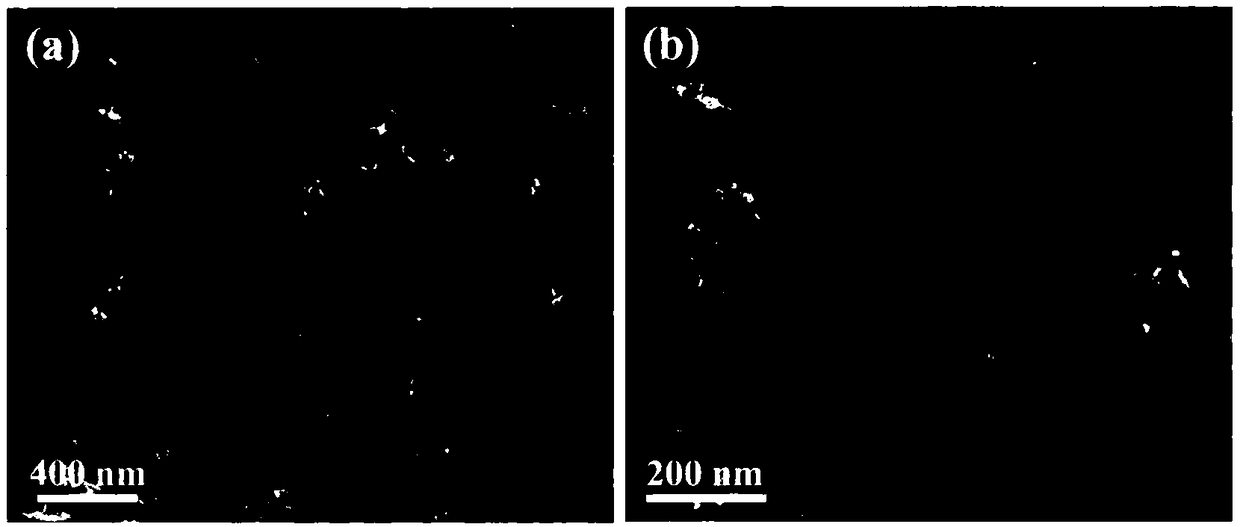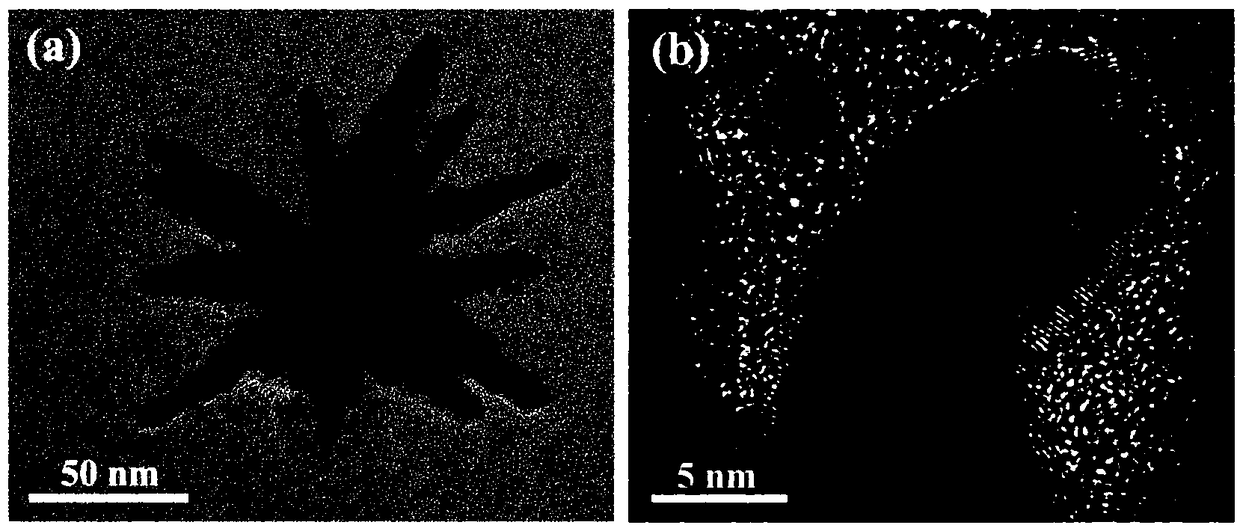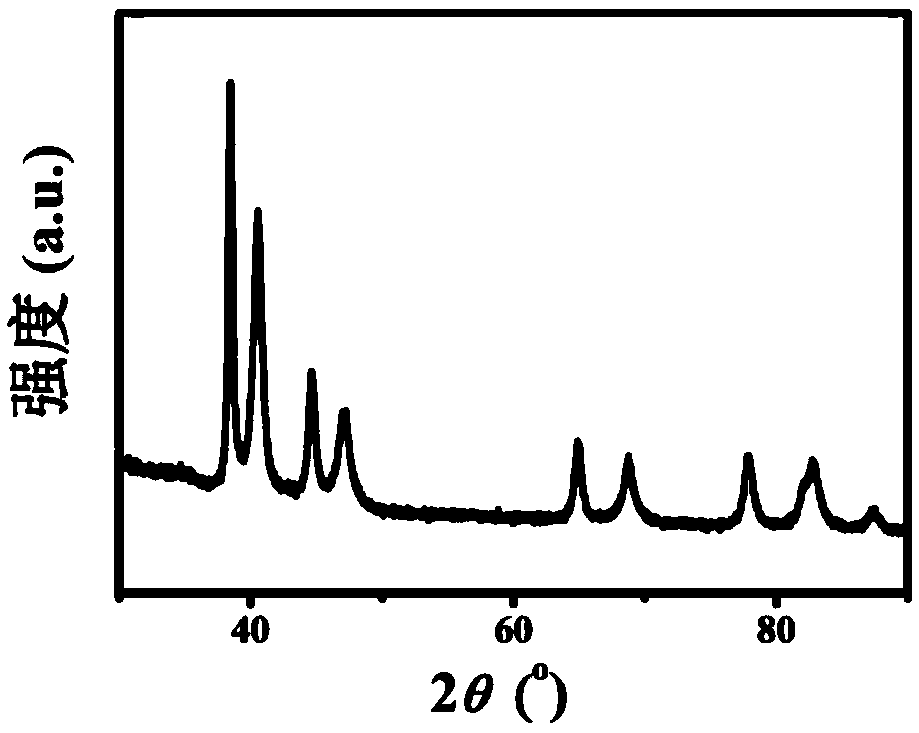Palladium-copper gold nanometer spinous electrocatalyst and preparation method thereof
A gold nano-catalyst technology, applied in nanotechnology, nanotechnology, nanotechnology for materials and surface science, etc., to achieve the effect of high yield, simple preparation method and high application prospect
- Summary
- Abstract
- Description
- Claims
- Application Information
AI Technical Summary
Problems solved by technology
Method used
Image
Examples
Embodiment 1
[0040] A preparation method of palladium-copper-gold nano-thorn electrocatalyst, said method comprising the steps of:
[0041] 1) prepare sodium chloropalladate, cupric chloride and chloroauric acid solution with a concentration of 20mM respectively, a hydrochloric acid solution with a concentration of 6M and an ascorbic acid solution with a concentration of 0.1M;
[0042] 2) Mix 2.5mL of sodium chloropalladate, 1mL of copper chloride and 1mL of chloroauric acid solution, then add 0.2mL of hydrochloric acid solution, then add 200mg of potassium bromide and 50mg of F127, mix well by ultrasonic; finally add 2mL of ascorbic acid solution , ultrasonically mixed for 20 minutes;
[0043] 3) After the solution is fully mixed, place it in an oil bath and heat it to 95° C., react for 30 minutes, wash, centrifuge, and dry to obtain the palladium-copper-gold nanothorn electrocatalyst.
[0044] The SEM figure of the palladium-copper-gold nanothorn obtained is shown in figure 1 . The TE...
Embodiment 2
[0047] A preparation method of palladium-copper-gold nano-thorn electrocatalyst, said method comprising the steps of:
[0048] 1) prepare sodium chloropalladate, cupric chloride and chloroauric acid solution with a concentration of 20mM respectively, a hydrochloric acid solution with a concentration of 6M and an ascorbic acid solution with a concentration of 0.1M;
[0049] 2) Mix 3mL sodium chloropalladate, 0.75mL cupric chloride and 0.75mL chloroauric acid solution, then add 0.2mL hydrochloric acid solution, then add 200mg potassium bromide and 50mg F127, and mix well by ultrasonic. Finally, 2 mL of ascorbic acid solution was added, and ultrasonically mixed for 20 minutes;
[0050] 3) After the solutions are fully mixed, they are placed in an oil bath and heated to 95° C., reacted for 30 minutes, washed, centrifuged, and dried to obtain the palladium-copper-gold multi-branched nanoparticle oxygen reduction catalyst.
[0051] Obtain the SEM figure of palladium-copper-gold mul...
Embodiment 3
[0054] A preparation method of palladium-copper-gold nano-thorn electrocatalyst, said method comprising the steps of:
[0055] 1) prepare sodium chloropalladate, cupric chloride and chloroauric acid solution with a concentration of 20mM respectively, a hydrochloric acid solution with a concentration of 6M and an ascorbic acid solution with a concentration of 0.1M;
[0056] 2) Mix 1.5mL sodium chloropalladate, 1.5mL cupric chloride and 1.5mL chloroauric acid solution respectively, then add 0.2mL hydrochloric acid solution, then add 200mg potassium bromide and 50mg F127, and mix well by ultrasonic. Finally, 2 mL of ascorbic acid solution was added, and ultrasonically mixed for 20 minutes;
[0057] 3) After the solution is fully mixed, place it in an oil bath and heat it to 95° C., react for 30 minutes, wash, centrifuge, and dry to obtain the palladium-copper-gold needle-shaped nanoparticle oxygen reduction catalyst.
[0058] Obtain the SEM figure of palladium copper gold needle...
PUM
 Login to View More
Login to View More Abstract
Description
Claims
Application Information
 Login to View More
Login to View More - R&D
- Intellectual Property
- Life Sciences
- Materials
- Tech Scout
- Unparalleled Data Quality
- Higher Quality Content
- 60% Fewer Hallucinations
Browse by: Latest US Patents, China's latest patents, Technical Efficacy Thesaurus, Application Domain, Technology Topic, Popular Technical Reports.
© 2025 PatSnap. All rights reserved.Legal|Privacy policy|Modern Slavery Act Transparency Statement|Sitemap|About US| Contact US: help@patsnap.com



